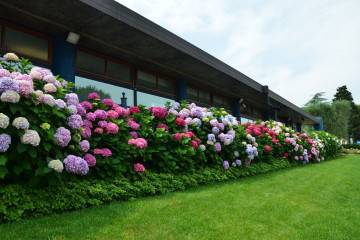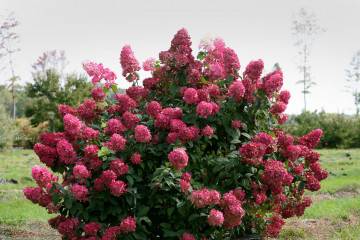Hydrangea Diamantino: a botanical description of a flower variety and care for it
Content:
To decorate a summer cottage, gardeners acquire various types of flowering plants. The hydrangea Diamantino deserves special attention. This shrub goes well with many herbaceous plants and will complement existing flowering compositions of one and perennials. Before buying and planting, it is recommended to study the description of the Diamantino hydrangea, the rules of care and the characteristics of the variety.
Characteristics of Diamantino hydrangea
Hydrangea paniculata is a flower from the Hortensian family that has been loved by the upper strata of society in England and France since the early 14th century.
Hydrangea paniculata Diamantino (Hydrangea paniculata Diamantino) is a high, up to 1.2 meters in height, dense bush. Shoots are upright, rather tough. Despite their height, they do not require a garter or support.
The leaves, located at the bottom of the ovoid stem, are colored bright green. The inflorescence reaches 20-25 cm in size. On it you can see many small sterile flowers tightly adjacent to each other.
It is distinguished from other varieties of hydrangea by its rounded shape. At the very beginning, the flowers are yellow-green in color, gradually acquiring a pure white color, and by the end they are painted in a delicate pink hue.
Breeding methods of the variety
To date, there are several ways to successfully reproduce hydrangeas:
- Cuttings. With the onset of spring and until mid-summer, the gardener cuts off a young viable shoot. The recommended size is 8-15 cm. All leaves are removed from the bottom and treated with a growth stimulant. After that, the cutting is planted in a greenhouse in fertile soil. Next year, in the spring, it will be a full-fledged plant, ready for transplantation to a permanent place.
- The division of the bush is carried out strictly in autumn or spring. To do this, the bush is completely dug up and carefully cut into several parts. After that, everyone is seated on a new site.
- Layers. For reproduction by this method, it is necessary to take a young one-year-old shoot. It is tilted to the soil and sprinkled on top. At least 15-25 cm of pagon should remain on the surface. After some time, the seedling develops its own root system, which allows it to be separated and planted in a new place.
Planting panicle hydrangea
When choosing a site, it is necessary to take into account that the plant is light and moisture-loving. In this case, the area should be well ventilated.
Planting plants in open ground is done in spring. The most favorable period is the period from the moment the soil thaws until the first buds appear on the trees.
First, a hole is prepared. It should be at least 50 cm deep and 40 cm in diameter. The recommended distance between adjacent bushes is 1 m. A large amount of peat, rotted humus or mineral fertilizer is placed on the bottom of each depression.
The root collar should be no more than 3 cm deep.Ignoring this rule will slow down the growth and development of the plant, as it will spend its energy on recovery and adaptation. When pouring the earth, it is necessary to carefully compact it so that no voids remain between the roots, otherwise they will dry out.
When the transplant is completed, the soil must be watered abundantly. It is best to direct the stream of water to the middle of the pit. If the ground has settled heavily, then you can add some more soil. Some gardeners mulch the surface with a seven centimeter layer of wood chips, bark and peat.
Flower care
Providing full care for this ornamental plant, the owner can be sure of abundant and lush flowering.
Watering
Hydrangea Diamantino loves abundant and regular watering. However, you should be extremely careful, because excessive moisture negatively affects the root system. She can start to rot and rot.
In hot weather, the flower should be watered about 2-3 times a week, but it is better to focus on the ground. Drying of the top layer indicates the need for moisture.
The stream of water is directed in such a way as to avoid falling on the leaves.
Top dressing
For lush and long-lasting flowering, it is important to regularly feed. Mineral fertilizers can be applied every 10 days, but very carefully. Organic ones are best: slurry or humus.
An excess of fertilizer causes the development of too large inflorescences, which, under the weight, can break the stem. However, if applied less often than 2 times a month, flowering will be scarce.
Pruning
It is very important to prune the plant regularly. The procedure is performed annually in early spring before the first buds appear. This has a positive effect on the splendor of flowering and the size of the bush, preventing it from growing and preserving its decorative effect. The plant does not have to spend energy on maintaining the viability of old or frozen shoots, and it will delight the owner for a long time.
Last year's branches are shortened in length by 2-3 buds, and in summer it is permissible to shorten the shoots of hydrangea even by 4-5 buds.
Rejuvenating pruning involves removing 1-2 old branches right at the base of the bush.
Diseases and pests
In the garden, hydrangea can be exposed to many diseases and pests. Dangerous include:
- Powdery mildew. It manifests itself in the form of a white coating on the leaves, which subsequently takes on a brown tint. Leaves wilt and fall off. To overcome the disease, the flower is treated with a mild soapy solution.
- Gray rot is expressed in the appearance of brown spots. It is a fungal disease that spreads very quickly in rainy weather.
- White rot affects the root system and is invisible to the gardener for a long time.
- Tracheomycosis - premature yellowing of the upper shoots and their wilting.
To avoid the development of these diseases, it is necessary to timely treat with preventive drugs and follow the rules of watering.
Among parasites, the following are common:
- snails that destroy foliage;
- nematodes - infecting the root system (unfortunately, the bush will die and cannot be restored);
- aphids and spider mites feed on foliage sap;
- leaf beetle, leafworm, weevil - gnaw and twist foliage.
To combat them, it is recommended to use insecticides.
Shelter for the winter
This hydrangea variety has a low frost resistance index. Therefore, the gardener must carefully prepare the Diamantino panicle hydrangea for the coming winter. A young bush is covered with spruce branches or spunbond. In regions with harsh climates, adult flowers are also protected. With the onset of early spring, the shelter is removed.
Hydrangea Diamantino is certainly a great option for decorating a flower garden on the site.Observing the rules of care and maintenance, the florist will admire its lush bloom for a long time, and the changing delicate shades will delight and admiration from the neighbors.





















